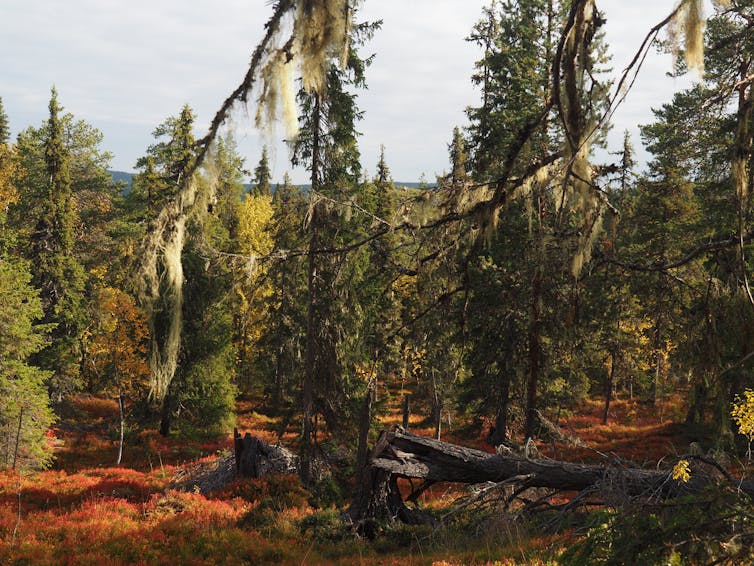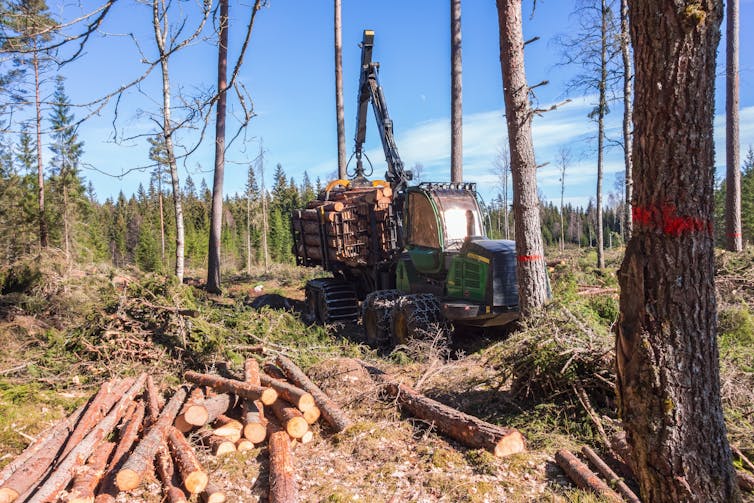
Ulrika Ervander, Author provided
Anders Ahlström, Lund University and Pep Canadell, CSIRO
Most of Europe’s natural ecosystems have been lost over the centuries. However, a sizeable amount of natural old forest still exists, especially in the north. These “old-growth” forests are exceptionally valuable as they tend to host more species, store more carbon, and are more resilient to environmental change.
Many of these forests are found in Sweden, part of the belt of boreal forests that circle the world through Canada, Scandinavia and Russia. But after researching these last relics of natural forest we have found they are being cleared rapidly – at a rate faster even than the Amazon rainforest.
There is no direct monitoring of these forests, no thorough environmental impact assessments and most of the public don’t seem to be aware this is even happening. Other evidence suggests something similar is happening right across the world’s boreal forests.
It can be tricky to know exactly how much old-growth forest there is, since the distinction might not always be clear. However, there is a clear difference between forests that have been “clear-cut” (entirely chopped down) sometime in the past and those that never have.
Clear-cutting started appearing in Sweden in the early 1900s and has been the dominant type of forestry in the country since the 1950s. The uncut forests that predate this time have therefore most likely not been clear-cut and since they are old they can be classified as old-growth forests.

Lasse Johansson / shutterstock
In our study, we looked specifically at forests in unprotected areas where the trees predated 1880 on average. That’s long before the large-scale adoption of clear-cutting in Sweden and means those forests have likely never been clear-cut.
These unprotected old-growth forests constitute around 8% of the productive forest land in Sweden, that is, the area that is generally favourable for forestry (omitting forests close to the Scandinavian mountain range tree line). This amounts to about 1.8 million hectares of old-growth forest, more than the total wooded area in many European countries.
This area of unprotected old-growth forest, with the remaining protected old-growth and primary forests, constitutes a large share of the last known ecosystems of “high naturalness” in the EU.
What is happening to these old-growth forests?
Between 2003 and 2019, 20% of all the clear-cut forest in Sweden was old-growth. This means a sizeable share of forest products, such as timber, paper and bioenergy, comes from old trees. The losses to unprotected old-growth forests amount to 1.4% per year, which means they will be lost completely by the 2070s if the trend continues.
To put this in perspective, Sweden’s old-growth forests have been cleared six to seven times faster than the Brazilian Amazon forest between 2008 and 2023. (Of course, given the size of the Amazon, the total amount of cleared forest is much larger there).
While our study, shockingly enough, appears to be the only of its kind across the boreal region, there is some research showing that old-growth forests are also harvested in Canada. Additional anecdotal evidence further suggests the unchecked loss of old-growth forests to forestry operations in other boreal regions .
What’s next?
The European Commission has drafted guidelines for all countries to map and protect all remaining old-growth and primary forests. This would be a good start.
But ultimately, we’ll need a coordinated system to map and monitor the entire boreal forest simply to learn the rate at which it is being lost. This would also help us understand the implications for carbon storage, for other plants and animals that live in these forests, and the humans that use them.
Unfortunately, this is a large and difficult task. Yet this might be one of our last chances to protect and recover large areas of natural forests. Logging old-growth forests now will delay their recovery for centuries.![]()
Anders Ahlström, Associate Professor, Department of Physical Geography and Ecosystem Science, Lund University and Pep Canadell, Chief Research Scientist, CSIRO Environment; Executive Director, Global Carbon Project, CSIRO
This article is republished from The Conversation under a Creative Commons license. Read the original article.